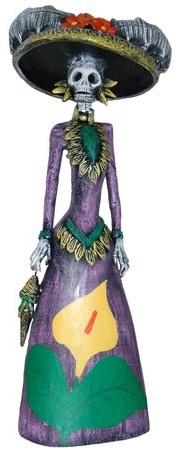In my family, all of the children are told the story of La Llorona (Lah-yoh-roh-nah) from a young age to make sure the kids listen to their parents. La Llorona lives in a remote village in the mountains with her husband and her two kids. One day she went crazy because her husband cheated on her and killed her kids. So she killed her husband and roams the country for her kids. And she would come to get you if you didnt listen to your parents.
Notes:
The subject told me that La Llorona is a popular legend for Mexican children between the ages of 2 and 11. She said that it was often used to keep the kids in line. Her mother told her of the lady who roamed the country for her kids, saying that if she did not behave, La Llorona would come to take her away. The subject said this frightened her greatly, and she was terrified of La Llorona for most of her childhood.
I had heard the tale of La Llorona before, although the version I heard was a little different. First of all La Llorona was also known as the weeping woman because she, not her husband, was said to have drowned her children after her husband left her for another woman, and unlike the subjects version she did not kill her husband. However the gist of the story was the same, with La Llorona spending the rest of her life as a ghost that searches the country for her children.
What I found interesting about this version was that it was used as a means of keeping children in line and behaved. Most times I have heard of this legend before it was recited as a scary story at campsites or in festivals to talk about the woman that could be heard weeping near the lake. However the subjects parents used the scary story to frighten the children into staying well-behaved so they would not be taken away by La Llorona. Since they were taught about La Llorona and how she goes after young children at such a young age, it was definitely engrained into their heads to behave.
This story is very common in Mexican and New Mexican culture, and because of this there are many variants, as there was a difference between the story I heard and the one she told me. However when I looked up La Llorona, there were an abundance of sites dedicated to La Llorona. One of then offers a few different versions where she is either considered a bruja (witch), sirena (siren), ramera (harlet), or a virgen (virgin). Each story is a little different with different reasons as to why she had to kill her kids. There is also a timeline of events that chronicles the first mention of La Llorona. The first mention of crying out to children occurs in 1502 in Tenochtitlan, where the goddess Cihuacoatl takes a woman form and cries out in the night, Oh hijos mios
yaha llegado vuestra destruccion. Donde os llevare? (Oh my children
your destruction has arrived. Where can I take you?) They believe she was talking about the future conquest of Mexico. (www.lallorona.com). The woman believed to be La Llorona is known as La Malinche, and her husband Cortes does not want to come back home because he is conquering more terrorities, so they send a beautiful woman to entice him. When Cortes returns, he intends to leave her behind, and La Malinche prays to the gods, they respond telling her that if she lets her children go with him one of them will return and kill your people. She then taks her babies to the lake bordering Mexico City and stabs her babies in the hearts crying out, Oh hijos mios! In 1530 she dies, and is given the name La Llorona (the weeping woman).
The website also has a list of poems, songs, and artwork dedicated to La Llorona as well as a list of peoples encounters and sightings.
www.lallorona.com Apr 24 2007.

